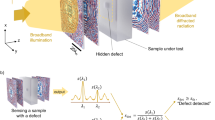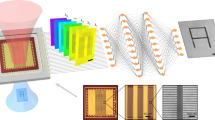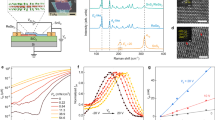Abstract
Advances in nanophotonics and plasmonics have led to the creation of a variety of innovative optical components and devices. However, the development of powerful practical applications has so far been limited. Here we show that subsurface defects in three-dimensional NAND flash memory devices can be identified by exploiting the inherent hyperbolic metamaterial structure of the devices and associated nanophotonic interactions, such as the epsilon-near-zero effect and hyperbolic Bloch mode formation. By incorporating a hyperspectral imaging scheme into an industrial optical inspection tool, we experimentally demonstrate that a diffraction-assisted volume-plasmonic resonance provides a robust mechanism for identifying subsurface defects at a depth that is around ten times deeper than the conventional optical skin depth limit. Further spectral analysis in the longer-wavelength infrared region shows clear hyperbolic guided-mode-resonance signatures that would potentially allow defect identification over the entire device depth and on the scale of multiple micrometres.
This is a preview of subscription content, access via your institution
Access options
Access Nature and 54 other Nature Portfolio journals
Get Nature+, our best-value online-access subscription
$29.99 / 30 days
cancel any time
Subscribe to this journal
Receive 12 digital issues and online access to articles
$119.00 per year
only $9.92 per issue
Buy this article
- Purchase on Springer Link
- Instant access to full article PDF
Prices may be subject to local taxes which are calculated during checkout





Similar content being viewed by others
References
Russell, P. S. T. J. & Birks, T. A. in Photonic Band Gap Materials (ed. Soukoulis, C.M.) 71–91 (Springer Netherlands, 1996).
Ding, Y. & Magnusson, R. Resonant leaky-mode spectral-band engineering and device applications. Opt. Express 12, 5661–5674 (2004).
Ebbesen, T. W., Lezec, H. J., Ghaemi, H. F., Thio, T. & Wolff, P. A. Extraordinary optical transmission through sub-wavelength hole arrays. Nature 391, 667–669 (1998).
Garcia-Vidal, F. J., Martin-Moreno, L., Ebbesen, T. W. & Kuipers, L. Light passing through subwavelength apertures. Rev. Mod. Phys. 82, 729 (2010).
Yoon, J. W., Lee, J. H., Song, S. H. & Magnusson, R. Unified theory of surface-plasmonic enhancement and extinction of light transmission through metallic nanoslit arrays. Sci. Rep. 4, 5683 (2014).
Campion, A. & Kambhampati, P. Surface-enhanced Raman scattering. Chem. Soc. Rev. 27, 241–250 (1998).
Kauranen, M. & Zayats, A. V. Nonlinear plasmonics. Nat. Photon. 6, 737–748 (2012).
Okamoto, K. et al. Surface-plasmon-enhaned light emitters based on InGaN quantum wells. Nat. Mater. 3, 601–605 (2004).
Song, J.-H. et al. Fast and bright spontaneous emission of Er3+ ions in metallic nanocavity. Nat. Commun. 6, 7080 (2015).
Hsu, C. W. et al. Observation of trapped light within the radiation continuum. Nature 499, 188–191 (2013).
Yoon, J. W., Song, S. H. & Magnusson, R. Critical field enhancement of asymptotic optical bound states in the continuum. Sci. Rep. 5, 18301 (2015).
Commercializing plasmonics. Nat. Photon. 9, 477 (2015).
Guler, U., Kildishev, A. V., Boltasseva, A. & Shalaev, M. Plasmonics on the slope of enlightenment: the role of transition metal nitrides. Faraday Discuss. 178, 71–86 (2015).
Weidanz, J. A. et al. Detection of human leukocyte antigen biomarkers in breast cancer utilizing label-free biosensor technology. J. Vis. Exp. 97, e52159 (2015).
Zhou, D. & Biswas, R. Photonic crystal enhanced light-trapping in thin film solar cells. J. Appl. Phys. 103, 093102 (2008).
Hill, M. T. & Gather, M. C. Advances in small lasers. Nat. Photon. 8, 908–918 (2014).
Challener, W. A. et al. Heat-assisted magnetic recording by a near-field transducer with efficient optical energy transfer. Nat. Photon. 3, 220–224 (2009).
Stokowski, S. & Vaez-Iravani, M. Wafer inspection technology challenges for ULSI manufacturing. In Characterization and Metrology for ULSI Technology: 1998 International Conference (eds Seiler, D. G. et al.) CP449 (AIP, 1998)
Lee, S. K. et al. Investigation of novel inspection capability for 3D NAND device wordline inspection. In 25th Annual SEMI Advanced Semiconductor Manufacturing Conference 278–282 (IEEE, 2014).
Tanaka, H. Bit cost scalable technology with punch and plug process for ultra high density flash memory. In IEEE Symposium on VLSI Technology 14–15 (2007).
Rakić, A. D., Djurišić, A. B., Elazar, J. M. & Majewski, M. L. Optical properties of metallic films for vertical-cavity optoelectronic devices. Appl. Opt. 37, 5271–5283 (1998).
Campione, S., Brener, I. & Marquier, F. Theory of epsilon-near-zero modes in ultrathin films. Phys. Rev. B 91, 121408(R) (2015).
Rytov, S. M. Electromagnetic properties of a finely stratified medium. Sov. Phys. JETP 2, 466–475 (1956).
Poddubny, A., Iorsh, I., Belov, P. & Kivshar, Y. Hyperbolic metamaterials. Nat. Photon. 7, 948–957 (2013).
Ferrari, L., Wu, C., Lepage, D., Zhang, X. & Liu, Z. Hyperbolic metamaterials and their applications. Prog. Quantum Electron. 40, 1–40 (2015).
Shekhar, P., Atkinson, J. & Jacob, Z. Hyperbolic metamaterials: fundamentals and applications. Nano Converg. 1, 14 (2014).
Orlav, A. A., Zhukovsky, S. V., Iorsh, I. V. & Belov, P. A. Controlling light with plasmonic multilayers. Phot. Nano. Fund. Appl. 12, 213–230 (2014).
Ferrari, L., Smalley, J. S. T., Faiman, Y. & Liu, Z. Hyperbolic metamaterials for dispersion-assisted directional light emission. Nanoscale 9, 9034 (2017).
Wang, S. S. & Magnusson, R. Theory and applications of guided-mode resonance filters. Appl. Opt. 32, 2606–2613 (1993).
Niraula, M., Yoon, J. W. & Magnusson, R. Single-layer optical bandpass filter technology. Opt. Lett. 40, 5062–5065 (2015).
Niraula, M., Yoon, J. W. & Magnusson, R. Mode-coupling mechanisms of resonant transmission filters. Opt. Express 22, 25817–25829 (2014).
Acknowledgements
This work was supported by the i-TAP (Innovative-Technology Advancement Program) of SK hynix Inc. We thank S. J. Moon and G. Ahn for providing us with the FTIR spectrum analyser and associated discussions.
Author information
Authors and Affiliations
Contributions
J.W.Y., S.-M.M., and S.H.S. conceived the original concept and initiated the work. S.M.M., Y.K., J.H., O.-J.K., and K.K. performed the optical inspection and FIB-SEM analysis. J.W.Y. and S.H.S. established the theoretical ground of the concept and performed the FTIR analysis. G.P.K., S.-M.M., and J.W.Y. performed the numerical analyses. All authors discussed the results. J.W.Y., S.H.S., and S.-M.M. wrote the manuscript. J.W.Y. and S.-M.M. contributed equally to this work.
Corresponding authors
Ethics declarations
Competing interests
The authors declare no competing financial interests.
Additional information
Publisher’s note: Springer Nature remains neutral with regard to jurisdictional claims in published maps and institutional affiliations.
Supplementary information
Supplementary Information
Supplementary Figures 1–6.
Rights and permissions
About this article
Cite this article
Yoon, J.W., Ma, SM., Kim, G.P. et al. Nanophotonic identification of defects buried in three-dimensional NAND flash memory devices. Nat Electron 1, 60–67 (2018). https://doi.org/10.1038/s41928-017-0007-7
Received:
Accepted:
Published:
Issue Date:
DOI: https://doi.org/10.1038/s41928-017-0007-7
This article is cited by
-
Filamentary Resistive Switching and Capacitance-Voltage Characteristics of the a-IGZO/TiO2 Memory
Scientific Reports (2020)
-
Electronic devices: Finding flaws in a flash
Nature Reviews Materials (2018)



